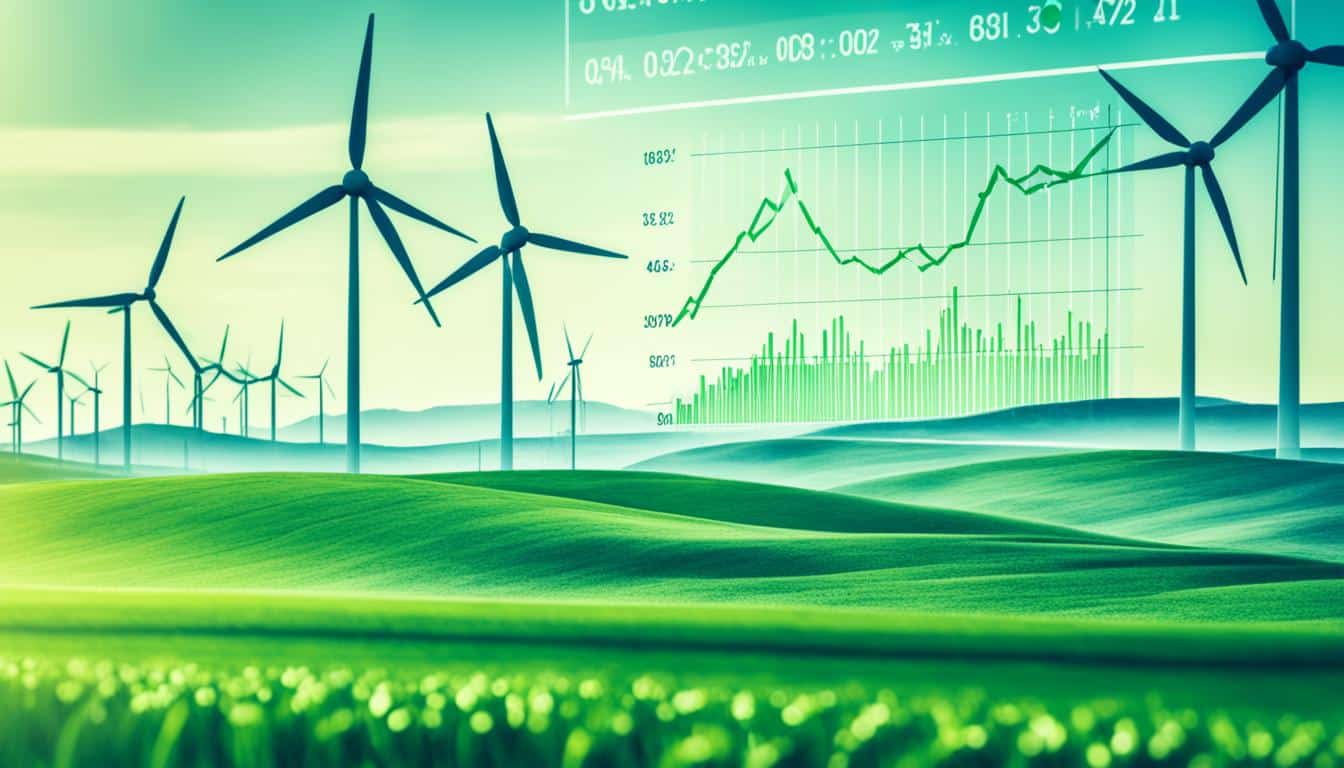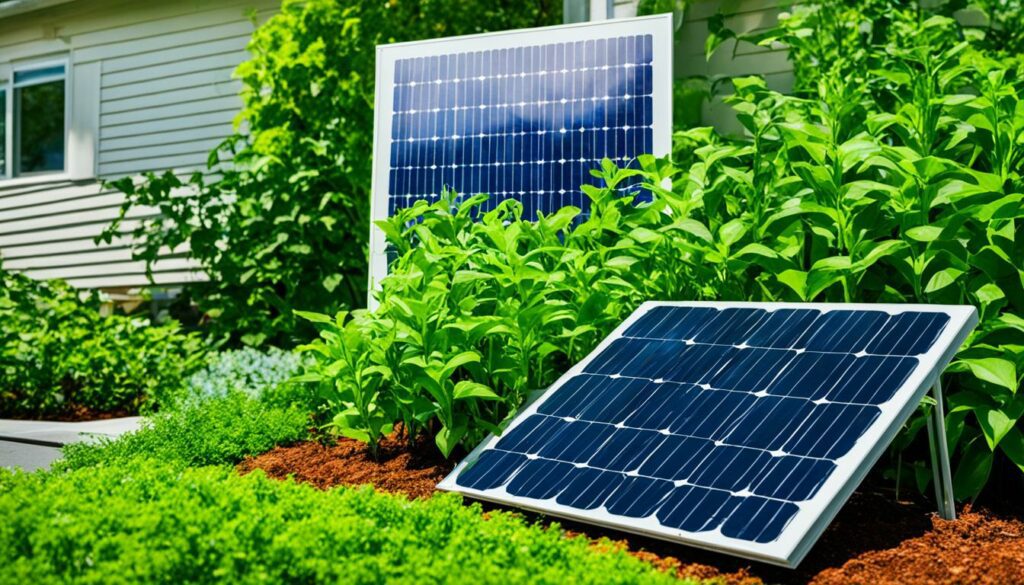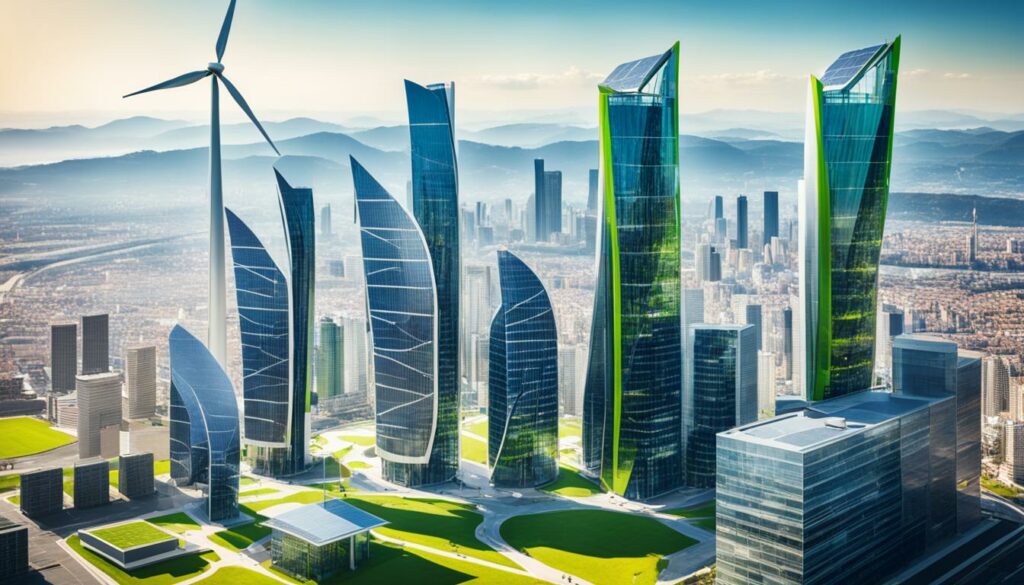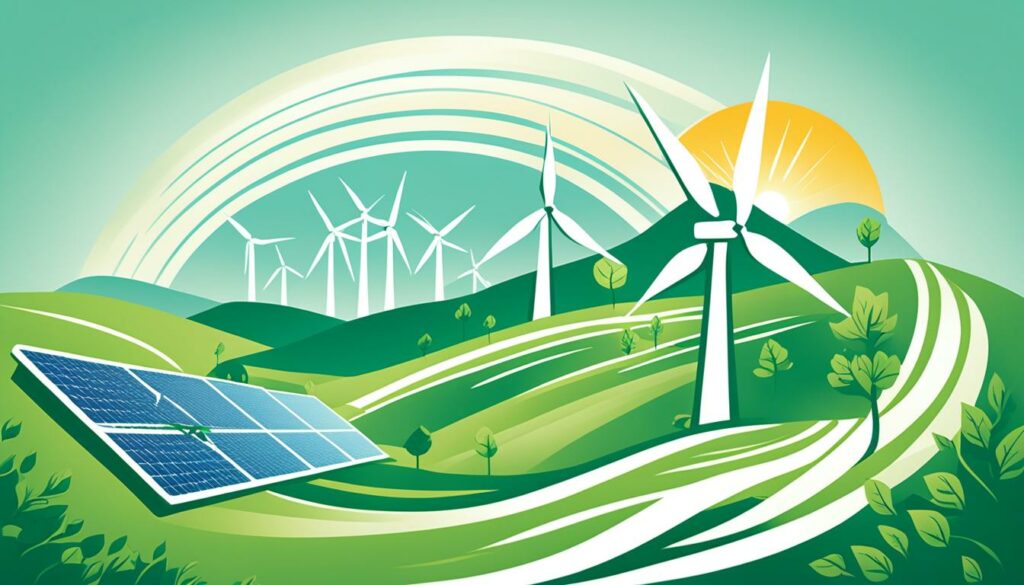Menu

Do you know the energy storage market will explode from 18 GW in 2020 to 176 GW by 2030? This shows a big need for new ways to fund green energy projects. We must find the best finance methods to move to cleaner energy sources. I will look into how we can use different financing options to boost eco-friendly projects worldwide.
State and local governments are leading the way with revolving loan funds (RLFs) for their green goals. These funds use public money in smart ways for energy improvements. RLFs help support green projects and are flexible and effective finance tools.
Grants from programmes like the EECBG can kickstart RLFs, especially for small projects with £250,000 or less. The money saved from lower bills pays back these loans, keeping the green cycle going. This also allows communities to invest more in other green projects, multiplying the benefits.
Internal RLFs are good for starting, but for bigger impacts, external RLFs can bring in more money from private companies. Pulling off external RLFs needs strong teamwork between government, finance experts, and stakeholders. Together, they make sure everything follows the rules and works smoothly.
Renewable energy financing is crucial for sustainable energy growth. It’s clear that finding funds and spotting investment chances are key. Without them, the spread of green tech worldwide would be slow.
Investing in green tech is very important. More green bonds are now available, making it easier to fund renewable projects. In the U.S., there are tax benefits like the Investment Tax Credit to encourage more green energy use.
Feed-in Tariffs (FiTs) help renewable energy makers by offering secure contracts over time. Crowdfunding lets many people support big green projects with small donations. Together, these methods attract more people to invest in renewable energy.
Now, there are many ways to invest in renewable energy that offer steady returns. These include Yieldcos and Green Investment Trusts. They are backed by insurances that protect against project risks.
A good financial plan is key to success, like having more debt than equity in solar projects. Taking advantage of low loan rates can reduce costs. But it’s also about getting cash returns early.
At the start, projects like offshore wind can need all-equity funding. Later, adding some debt can make things more profitable. Working with partners and using grants can lay a strong financial base for new projects.
The future looks bright for those wanting to invest in renewable energy. Using debt after a project starts can open doors for more investments. Yet, managing risks well in the beginning is vital. This means doing market research, getting the right permits, and having a strong plan.
| Investment Strategy | Benefits |
|---|---|
| Green Bonds | Increased issuance supporting renewable projects |
| Tax Credits | Incentives such as ITCs to encourage adoption |
| Feed-in Tariffs | Guaranteed returns over a specified period |
| Crowdfunding | Collective small capital contributions for large projects |
| Yieldcos & Green Investment Trusts | Predictable cash flows and regular dividends |
| Performance Guarantee Insurance | Compensates for unmet performance standards |
| Construction All Risk Insurance | Covers damage and injury risks during construction |
In today’s world, using renewable energy is key. We need many ways to fund these projects. This part looks at different methods and their benefits for everyone involved.

Loans from groups like the SBA and USDA help push forward green projects. Small businesses, farmers, landowners, and makers can switch to green sources. They can use wind, solar, water, or heat from the ground. Greater Commercial Lending helps with both short and long-term loans for clean projects. Its CEO, David Wentworth, says getting money at good rates is a big plus.
| Provider | Target Group | Energy Source | Key Benefit |
|---|---|---|---|
| SBA & USDA | Small businesses, agricultural producers | Wind, solar, hydroelectric, geothermal | Transition to sustainable energy |
| Greater Commercial Lending | Businesses | Various renewable sources | Competitive project capital rates |
Revolving Loan Funds are a new way to finance green projects. The idea is to reuse the money for more projects. So, as one project pays back, it funds another. This makes the money go further, helping more green ideas happen over time.
Third-party models like PPAs and solar leases cut startup costs for businesses and homeowners. A third party covers the system’s costs. The user pays for the energy or leases the system. This makes green energy more available, breaking down financial walls to its adoption.
Revolving Loan Funds (RLFs) are a unique way to finance energy projects. They work by reusing money to fund new projects. This method is important for keeping energy projects moving.
RLFs act like a cycle, re-lending money as old loans get paid. This keeps the fund always ready to help new projects. They are key in supporting energy projects. Refer to Contract No. DE-AC36-08GO28308 and Technical Report NREL/TP-7A30-51399, revised July 2011, for how they are set up.
RLFs have several benefits. They make public funds more effective by reusing money. This means more projects can be funded. They also keep costs low, making it easier to start new energy-saving projects.
Energy service companies, like ESCOs, promise savings when using RLFs with Energy Savings Performance Contracts (ESPCs). This makes them very useful in financing energy projects.
Starting an RLF requires careful planning. First, an energy audit checks what projects will save money. It’s also crucial to know how interest rates affect the costs and returns of these projects.
Looking at past RLF grants from the EPA helps in the setup. Knowing how long these grants typically last is important. Refer to information from the EPA and experienced professionals.
| Parameters | ESPC | RLF | Combined Options |
|---|---|---|---|
| Energy Audit | Required | Required | Required |
| Cost Savings Guarantee | Yes | No | Yes |
| Flexibility in ECMs | High | High | Maximum |
| Interest Rate Impact | Significant | Significant | High |
Important figures in developing these guidelines are Chani Vines and experts like Karen Clifton. See Table 1: Comparison of ESPC, RLF, and Combined Options, part of the U.S. Department of Energy’s Office of Energy Efficiency and Renewable Energy.
By following these steps, local leaders can make the best of RLFs for clean energy. This shows how hard work and planning, backed by the National Renewable Energy Laboratory, can support big projects.
The Montana Alternative Energy Revolving Loan Program (AERLP) boosts green energy for 15 years now. This renewable energy case study shows how it tackled early hurdles, found funds, and made big changes in the area.

Starting with source Stimulus funding was added in 2009, the Montana Alternative Energy Revolving Loan Program has lent over $1 million. It gives low-interest loans for green projects. People and companies can apply, with large loans up to $60,000 or $100,000.
Loans start at a low 4% interest rate. This makes it cheap to choose green technologies like solar, wind, and more. Applying is quick, with no fees. It takes about two weeks to hear back, making it easy for everyone.
So far, over 50 projects have been helped. These loans work so well that all paid-back money goes to new green projects. One great success is the energy saving at the Montana Veterans Nursing Home from a special program. They saved $27,000 a year thanks to a $400,000 grant. This grant also helped get $900,000 from the state, making savings and upgrades possible.
The Montana State University (MSU) is also making a big impact. With $300,000 in grants from the DEQ, they started 18 recycling projects. MSU is also spreading green ideas at big events. E-waste and more recycling started, reducing trash in three counties.
Another big move is the $169,000 grant for electric buses at the University of Montana. They bought two 40-foot buses. Now, these are the first student-owned electric buses in the country, showing the real change from the Montana Alternative Energy Revolving Loan Program.
Green energy loans play a key role in advancing clean energy initiatives. They are provided by many organisations including the SBA and USDA. Their goal is to help those in rural areas, such as small businesses and farmers. These loans cover various renewable energy projects and upgrades. They also help create new jobs and make life better in communities.
These loans help fund all kinds of renewable energy projects. They cover costs like technology, equipment, and development. With this help, businesses can utilize clean energy sources. The SBA 504 Loans and USDA REAP Loans offer major funds at good rates, making the switch to green energy easier.
The loan terms last up to 20 years, with interest rates capped at 6%. Thanks to affordable rates, these loans are very useful for encouraging green projects.
Both sides, borrowers and lenders, enjoy many benefits from these loans. Those borrowing see their energy bills reduced, and they save on maintenance costs. Using green sources also helps protect the environment. When starting a project, borrowers must show it’s likely to succeed through an energy audit or study.
Lenders profit by funding eco-friendly projects. This involvement opens new business opportunities and helps the local community. A set system means these loans are well managed, ensuring everyone benefits.
| Loan Aspect | Details |
|---|---|
| Loan Size | Up to $250,000 |
| Loan Term | Not to exceed 20 years |
| Interest Rate | Typically not exceeding 6% |
| Application Fee | 1% of loan amount |
| Administration/Program Fees | 1.5% of allocation for software & servicing system licensing & set up |
| Loan Closing Fee | 1% of loan amount |
| On-going Servicing/Guaranty Fee | 20 bps on outstanding principal balance annually |
| Economic Benefits | Job creation, improved properties, reduced maintenance and repair costs, increased efficiency, health, and comfort of buildings |
Tax credits are key in helping renewable projects grow. They offer huge financial benefits to those involved. This encourages the use of clean energy.
Tax credits like the ITC and PTC boost green projects. Solar PV systems are eligible for a 30% credit if installed between 2022 and 2032. This percentage will reduce to 26% in 2033 and 22% in 2034, then expire in 2035.
There’s no limit to the credit amount, making it good for any size investment.

The Inflation Reduction Act’s Direct Pay provision is a big step. It helps non-profits and public projects that can’t use regular tax credits.
It means they get the credit’s value as cash, boosting their chance to do more in renewable energy.
There are also benefits like coverage for various project stages and tax insuranc. This insurance helps protect against loss of tax credits. It ensures smooth project financing, making a project’s success more certain.
This system is made strong by trusted insurers. It boosts the faith others have in investing in renewable energy. This helps developments stay solid in the long run. And getting tax insurance covers not just lost credits. It also protects against other costs, offering a full solution for unexpected issues.
Community land trusts are changing how we see renewable energy. They help put solar projects in both the city and countryside. This brings big benefits to the environment and the money people save.
Community land trusts are great at setting aside land for solar energy. For example, the Southside Community Land Trust has over 52 gardens helping over 3,000 families. They also have spots for 25 farmers.
They show how land can be used for farming and renewable energy. So, by adding solar, they help meet goals for a cleaner future.
Community land trusts focus on helping those with lower incomes. By having solar power, families save money and are less reliant on others for energy. This really helps them financially.
These trusts also teach farmers and kids. This helps the community now and in the future. It’s a great all-round effort.
Adding solar to these trusts helps everyone. It moves us towards green energy and helps those who struggle more with their bills. This mix of good land use and new energy ideas can be used everywhere. It’s a model for community action all over the country.
In our push for a green future, public-private partnerships (PPPs) are key. They bring together the public and private sectors to work on renewable energy projects. These partnerships share knowledge, funds, and new ideas, boosting the chances for green investments.

PPPs offer many perks like sharing resources and reducing risks. They mix government support with the private sector’s innovation. This creates a solid plan to use clean energy better.
This approach also means rules are clearer, projects run smoother, and money comes in from many sources. All this helps make using green energy much easier.
Around the world, PPPs have done great things for renewable energy. Australia encourages more clean electricity with special goals. Brazil sells energy through auctions, pushing for more renewable power.
Chile also uses laws to get people to invest in green energy. Germany leads in using various clean sources for power. And Lao PDR plans to make 30% of its energy from renewables by 2025.
The Philippines has set big goals for using more renewable energy. These efforts show together, we can do a lot to go green.
Structured finance helps lessen the risks in renewable energy projects. It uses complex financial tools. This makes it easier for investors to deal with the unknowns in big green energy ventures.
It involves using special financial setups to reduce the risk for everyone. This method tailors the finance for green energy. It matches the project’s financial needs and risks.
It includes using assets to create securities and specific financing models. These are great for the green energy area. They suit the high costs and need for strong financial plans well.
Lots of thought goes into managing risk in renewable energy. Structured finance makes this systematic. It helps make projects financially secure for the long run.
Here are some numbers showing how effective this is:
| Financial Aspect | Amount | Impact |
|---|---|---|
| Customer Savings | $37 million | Lower electricity costs through cleaner energy |
| Bondholder Benefits | $150 million | Early investment exit with risk-adjusted returns |
| Termination Payment | $255 million | Potential reinvestment in renewables |
| Worker Compensation | $137 million | Salaries covered during transition period |
In the end, structured finance is key for investing in renewable energy. It makes projects safer financially and lowers risks. Knowing and using these tools can help achieve big benefits and support green energy projects.
The government has a crucial part in switching to sustainable energy. They come up with key policies and ways to pay for renewable projects. This support is major for the growth of renewable energy.
For renewable energy to work well, it needs strong policies. The Paris Agreement, which aims for more low-carbon investments, shows international goals. Governments also use tools, like feed-in tariffs, to boost green energy use. Through these means, they push for more investment.
Additionally, by putting money into research, they help create new renewable technologies. This leads to more green patents and advancements in energy.
The government helps many important financial models for renewable energy. For example, the cost for big solar power has dropped a lot because of their support. The IEA says we’ll need over 6 trillion dollars by 2040 to meet climate goals.
But, complex rules can sometimes slow down the investment in big renewable projects. When the government has a big say in how things are run, it generally leads to more green investments.

More than 70 factors affect how much renewable energy money countries get in the OECD and G20. For example, how easy it is to start a business and the climate policies in place matter a lot. Strong climate rules and special incentives attract more money, as shown in past investments.
| Government Policies | Impact on Investments |
|---|---|
| Paris Agreement | 29% increase in low-carbon investments |
| Feed-in Tariffs | Driven investment between 2000-2014 |
| Public RD&D Spending | Encourages patenting and innovation |
| Capital Cost Reductions | 20% decrease for solar and wind |
The government’s work with green energy, through smart policies and funds, is key. They need to keep focusing on good rules and helping with money. This way, they can keep growing renewable energy and make our world greener.
For further details, have a look at this detailed OECD report on the government’s role in mobilising investment and innovation in renewable energy.
The private sector is key in advancing renewable energy. With fossil fuels supplying about ninety percent of the world’s energy, investing in renewables is crucial. Private funding helps tackle this need and moves us towards a greener future.
Private investors have many chances to put their money in renewable energy. By 2020, these investments could lower CO2 emissions by 9,000 Mt. That’s a big 40% cut. They could support projects like solar, wind, bioenergy, and hydroelectric. This would mean less risk for fuel supplies, more local jobs, and a variety of resources.
The world will likely need a lot more energy by 2050, especially in places still developing. But, some banks see clean energy tech as too risky. This view holds back the market. Yet, using smart finance can make it safer for investors. Not to forget, about 60% of the money for clean energy in markets like this will have to come from businesses. It might reach USD 1.1 trillion a year by the early 2030s.
| Statistics | Details |
|---|---|
| Total energy investment in EMDEs | Approximately USD 770 billion per year, with China accounting for two-thirds |
| Annual investment needed to align with the Paris Agreement | USD 2.2-2.8 trillion per year by the early 2030s |
| Public funding in EMDE clean energy spending | Around 50% |
| Private sector contribution required | USD 0.9-1.1 trillion annually by the early 2030s |
| Cost of achieving universal access to electricity and clean cooking fuels by 2030 | Approximately USD 45 billion per year |
Private funding is vital for growing renewable energy investments. These efforts cut CO2 and bring other big benefits. They make renewable energy a core part of a sustainable future. To make this happen, governments and banks must team up. They should lower the risks and push for more investment in green tech.
Nonprofits and local governments are key players in the push for renewable energy. They can use tax credits to help the environment and their local area. This boosts both sustainability and the economy.
Tax credits have grown with the Inflation Reduction Act (IRA), giving big financial chances to fund clean energy projects. This includes a way for tax-exempt groups to get a cash payment. This cash is like getting back the tax credit for clean energy projects.

Entities like nonprofits, local governments, and schools can use these credits. This is for projects like solar panels, wind turbines, and places to charge electric cars. They can also get tax breaks for buying clean vehicles. This helps a lot financially.
Renewable energy helps the environment and builds up the local community. Things like solar panels and electric car chargers cut energy costs and create jobs. The Investment Tax Credit (ITC) gives a big discount for projects with solar, wind, or geothermal energy.
There are also rebates, state help, and IRA incentives making it even more affordable. This supports the growth of clean energy in public places like schools or hospitals. These places are vital for the community, and this move makes them stronger and sustainable.
By 2024, the IRA will help make clean energy equipment more affordable for people with low to moderate incomes in New York. This will make it easier for them to join in on clean energy. Also, groups can spread the word about these benefits. They direct people to local help centers for more information and support.
Renewable energy has a bright future, but big challenges remain. These hurdles make it hard to get enough money for projects. They slow down progress in the renewable energy field.
There are several risks in financing renewable energy. A rise in interest rates can increase project costs every year. Over two years, this could mean projects cost 8-10% more. The issue is made worse by the low global finance alignment. For example, less than 1% of financing comes from grants and loans, and banks only bring in a dollar of private finance for every dollar lent. Developing countries are far behind in funds, needing $0.5 trillion yearly but getting much less.
Most renewable investments come from developed countries and China. But, these investments are not spread evenly, with many places missing out. Places like Southeast Asia saw less money coming in recently. Also, not all renewable projects are the same. They face different risks based on their technology and where they are. These can include changes in resources, delays, and part failures.
There are ways to solve these problems and encourage more investment in clean energy. Diversifying where the money comes from and increasing the use of loans and grants can help. It could give more places the money they need. Investing more in the power grid and storing energy better is also key. These areas need more investment by 2030 to meet climate goals. Governments can also help by making policies that support long-term projects.
It’s also important for the public and private sectors to work together. This can help fill the gaps in investment and bring new ideas. Making sure projects have good warranties and follow best practices boosts investor trust. Building stronger international partnerships will also help. It’s crucial to pay more attention to places that are just starting to grow. This would help move more money and effort there.
| Challenge | Impact | Potential Solutions |
|---|---|---|
| Interest Rate Increases | 8-10% Project Cost Rise | Diversify Funding, Public Policies |
| Geographical Imbalance | 80% of Investments from Developed Countries | Focus on Emerging Economies |
| Resource Variability | Unpredictable Output | Risk Mitigation, Long-term Contracts |
The future of renewable energy investment looks bright, full of changes. These changes come from new ways to finance projects and areas where growth is happening. For example, Bloomberg says we might need between $94–175 trillion to keep the world cooler. So, it’s very important to find good ways to pay for and use renewable energy.
New ways to pay for solar, wind, and other renewable energies are popping up. This includes using loans for switching to cleaner energy, starting from 2024. The cost of solar and wind power is now often lower than the price of oil and coal. This makes renewable energies more appealing to invest in. Also, the U.S. plans to put around $369 billion towards a cleaner energy future over the next ten years. This will help a lot.
Many exciting areas for renewable energy growth are on the horizon. By 2030, the U.S. plans to boost its solar, wind, and energy storage abilities by over 600 gigawatts. Clean hydrogen is also set to become a big $700 billion market by then. This growth is thanks to the help of the United States’ 2021 infrastructure bill. Plans for electric cars and building charging points, needing $1–1.4 trillion by 2040, are also on the rise. And, more money is going towards clean energy than ever.
The future of putting money into renewable energies is really important. It helps not just with making money but also with fighting climate change. By using new money methods and focusing on growing areas, we’re ensuring our energy source will be green and safe. Your investments today will make for a cleaner, strong renewable energy world down the line.
Investment in renewable energy is key. It helps bring sustainable energy solutions to life. By funding green technologies, we make clean energy available around the world.
The renewable energy field is growing fast, creating many investment chances. In the future, we’ll see new ways to fund projects. More investors will understand the value of putting money into renewable energy.
Green energy loans offer a way to support renewable projects. They open up these initiatives to more people. By using these loans, we can lower energy costs and help the planet.
RLFs are funds that keep money moving to new energy projects. They help make the most of public money. Also, they ensure there’s always support for green energy projects.
To create a RLF, you need to get some starting money. Then, set clear rules and manage it well. This way, the fund can keep supporting new clean energy ventures over time.
This loan program in Montana is a good example of a RLF at work. It aims to boost the use of alternative energy and save energy by offering easy-to-get loans.
Tax credits lower the cost of using renewable energy. They help developers and investors save money. This makes projects more attractive, especially for non-profits and the public sector.
Community land trusts make it easier to use land for solar power, helping those on low incomes. This way, people get affordable homes and rely more on their own energy.
When public and private groups work together, they can do more. By combining their resources and know-how, they find new solutions. This has helped the green energy field grow faster.
Structured finance offers special ways to handle and spread out the risks that come with investing in renewable energy. This makes such investments safer and draws in more investors.
Governments use several tools to back renewable energy. They offer things like tax breaks, grants, and loans with low interests. This boosts the desire to invest and helps the market grow.
The private sector plays a big part in moving renewable energy forward. By investing, private parties help meet worldwide green goals. In return, they earn from these sustainable projects.
Nonprofits and local governments can seize tax benefits and support from their communities to fund renewable energy. This boosts local economies. They help build places that are ready for the future.
Getting started can be expensive. Also, dealing with rules and risks can be tough. To move forward, we need smart plans, helpful policies, and new ways to finance that attract and keep investors interested.
There’s a lot of promise in the future for putting money into renewable energy. We’ll see new ways to finance and more chances to invest. As tech gets better, and we understand more about sustainability, this field will really take off.